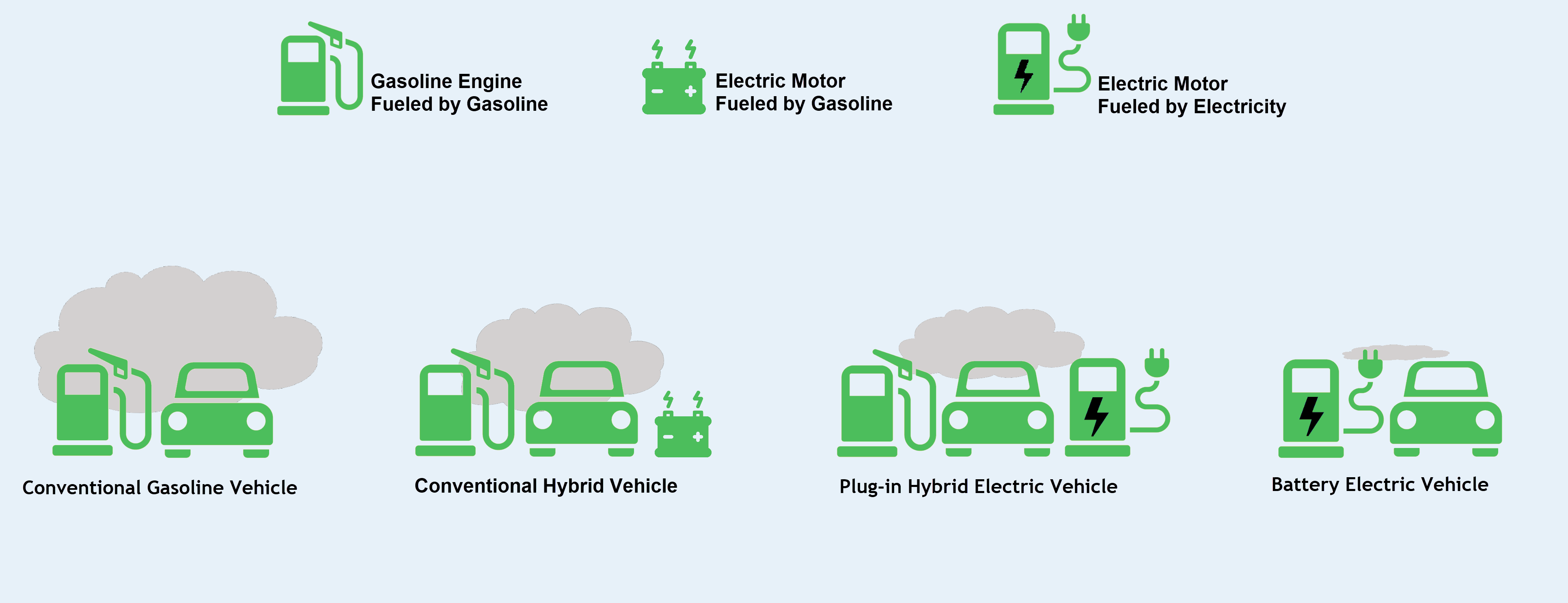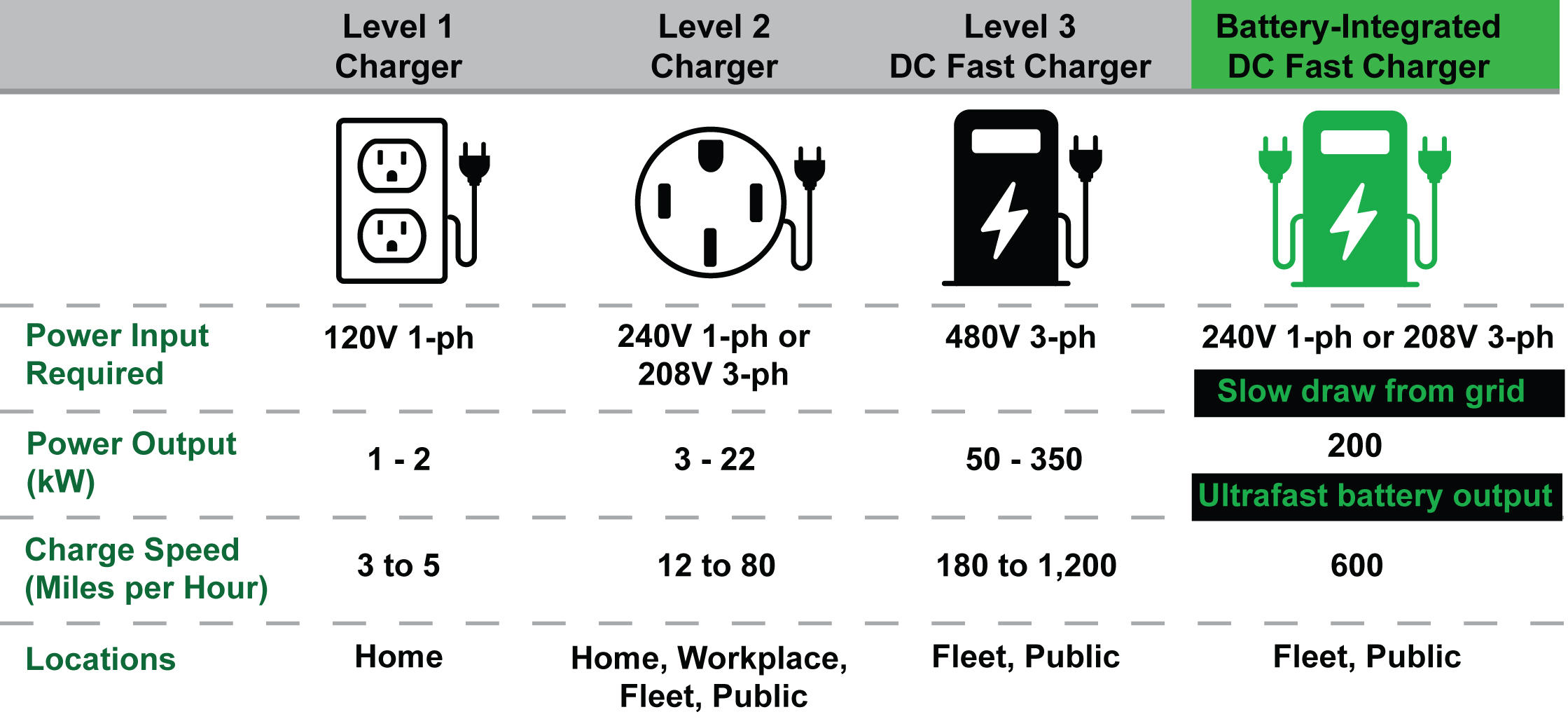Electric Vehicles (EV)

An Introduction to Electric Vehicles
This section provides an overview of Electric Vehicles (EVs), including different types, how to manage them in a fleet, and important considerations for agencies.
Different Types of Electric Vehicles (EV)
See the graphic illustration below including alt text or scroll down for full descriptions of each type.

Conventional Internal Combustion Engine (ICE)
Your conventional engines, powered by gasoline, diesel, biofuels or even natural gas. These make up the bulk of the vehicles on the road, and you are likely very familiar with them. While today's ICEs are significantly more efficient and have lower emissions than those from decades ago, the fundamental technology — burning fuel to create power — remains the same.
Hybrid Electric Vehicle (HEV)
These vehicles use both an internal combustion engine and an electric motor. The battery recharges automatically through energy from the engine and a process called regenerative braking, which captures kinetic energy during deceleration. This allows the vehicle to be more fuel-efficient, especially when starting and stopping.
Plug-in Hybrid Vehicle (PHEV)
A PHEV also uses both a gasoline engine and an electric motor. The key difference is that the battery can be recharged by plugging it into an external power source. PHEVs typically have a greater all-electric range than standard hybrids and can often run on just battery power, just gasoline, or a combination of both.
Electric Vehicle (EV)
Also known as a "Full Electric" vehicle, an EV is powered exclusively by a rechargeable battery. The only way to refuel an EV is to plug it into an electrical outlet or charging station. These vehicles are very efficient to operate but have a limited range, typically between 150 and 300 miles per charge.
Note: Like ICE vehicles, EVs and PHEVs also have a 12-volt lead-acid battery to power accessories and other systems, in addition to the high-voltage main battery that powers the motor.
Conventional Internal Combustion Engine (ICE)
Your conventional engines, powered by gasoline, diesel, biofuels or even natural gas. These make up the bulk of the vehicles on the road, and you are likely very familiar with them. While today's ICEs are significantly more efficient and have lower emissions than those from decades ago, the fundamental technology — burning fuel to create power — remains the same.
Hybrid Electric Vehicle (HEV)
These vehicles use both an internal combustion engine and an electric motor. The battery recharges automatically through energy from the engine and a process called regenerative braking, which captures kinetic energy during deceleration. This allows the vehicle to be more fuel-efficient, especially when starting and stopping.
Plug-in Hybrid Vehicle (PHEV)
A PHEV also uses both a gasoline engine and an electric motor. The key difference is that the battery can be recharged by plugging it into an external power source. PHEVs typically have a greater all-electric range than standard hybrids and can often run on just battery power, just gasoline, or a combination of both.
Electric Vehicle (EV)
Also known as a "Full Electric" vehicle, an EV is powered exclusively by a rechargeable battery. The only way to refuel an EV is to plug it into an electrical outlet or charging station. These vehicles are very efficient to operate but have a limited range, typically between 150 and 300 miles per charge.
Note: Like ICE vehicles, EVs and PHEVs also have a 12-volt lead-acid battery to power accessories and other systems, in addition to the high-voltage main battery that powers the motor.
Understanding EV Chargers
There Are Three (3) Levels of EV Chargers
See the graphic illustration below including alt text or scroll down for full descriptions of each charger level.

Types of EV Chargers
| Attribute | Level 1 Charger | Level 2 Charger | Level 3 DC Fast Charger | Battery-Integrated DC Fast Charger |
|---|---|---|---|---|
| Power Input Required | 120V 1-ph | 240V 1-ph or 208V 3-ph | 480V 3-ph | 240V 1-ph or 208V 3-ph Slow draw from grid |
| Power Output (kW) | 1-2 | 3-22 | 50-350 | 200 ultrafast battery output |
| Charge Speed (Miles per Hour) | 3 to 5 | 12 to 80 | 180 to 1,200 | 600 |
| Locations | Home | Home, Workplace, Fleet, Public | Fleet, Public | Fleet, Public |
Level 1 Charger: Uses a standard 120-volt AC outlet, common in homes. This is the slowest charging method. 1-2 power output (kW). 3 to 5 charge speed (Miles per Hour).
Level 2 Charger: Uses a 240-volt AC outlet (similar to a dryer outlet) and is common for home and public charging. It charges significantly faster than Level 1. 3-22 power output (kW). 12 to 80 charge speed (Miles per Hour).
Level 3 (DC Fast Charging): The fastest charging method, 480v 3ph, primarily found at public charging stations along major corridors. 50-350 power output (kW). 180 to 1,200 charge speed (Miles per Hour).
For more details on the differences between EV chargers, you can review the EV Chargers information.
Agency Information
Tools for Calculating Electric Vehicle Fleet and Utility Line Impact
You can estimate the electrical load by taking the miles traveled by your fleet vehicle (from a CARS report) and multiplying it by 0.33 kWh per mile. Work with your agency's Facilities team to multiply this number by the cost per kWh to understand the utility expense increase. This cost will be paid by SFM and must be reported monthly by vehicle. For a quick calculation, you can use the Choose EV calculator.
Take-Home EV Charging — Employee Reimbursement Guidelines
The Office of the State Controller holds the policy on all reimbursable events. The Electric Vehicle Home Charging Policy must be followed prior to the assignment of an electrified Take-Home vehicle. Electrification requires several unique considerations. The Colorado Energy Office provided Electric Vehicle Take-Home Guidelines and FAQs. will provide you the direction to support the implementation of vehicle electrification for all our operations.
The EV Home Charging Reimbursement Request Form must be completed for every participant before reimbursement will begin. Additional information can be found in the article, Everything you need to know about EV Home Charging.
Additional Resources
- Vehicle Utilization/Buying Electric Vehicles
- EV/PHEV Information
- EV Suitability Report
- ChargePoint Resources
Links for Video Resources
- Driving an Electric Vehicle [EV]
- F-150 Lightning EV: How to START and SHIFT
- Battery Preconditioning for efficient charging [Ford F150 lighting]
For answers to common EV questions, please visit our FAQ page.